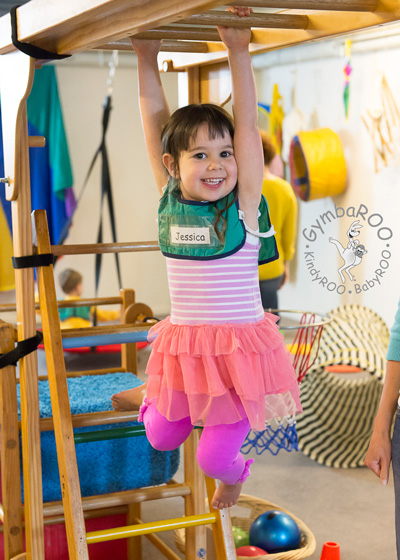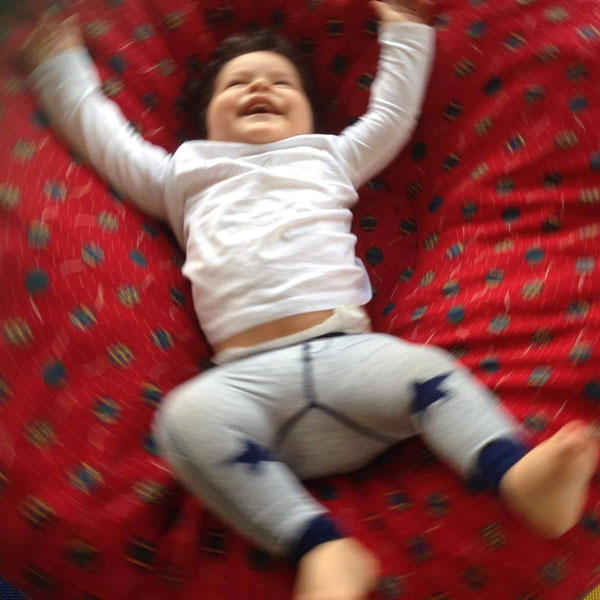Join the thousands of parents already raising smarter, happier babies with our online baby classes: The Active Babies Smart Kids series. Click here.
GymbaROO-KindyROO kids are excelling academically, emotionally, in leadership roles and on the sporting field. Find us at: GymbaROO-KindyROO
Dr Jane Williams and Bindy Cummings
You will have noticed that GymbaROO and KindyROO classes involve a lot of swinging. Your babies and children oscillate back and forth on swings, trapezes, in hammocks, inside suspended rollers, on top of rollers, in our arms as we dance and eventually, when they brachiate across the overhead ladders… just to mention a few! Our little ones love to swing, however this is not solely because it’s so much fun. Babies and children crave activities that are developmentally good for them and swinging is right up there for providing excellent stimulation to bodies and brains.

In his article: ‘What’s the Big Deal About Swinging?’ Tom Norquist says: “When we think about why most humans truly enjoy swinging, we need to break down what is actually happening. While swinging, we experience a full range of sensation, from the calming rhythm of our to-fro movement to the excitement of rapid travel through space and time. These experiences are linked to pre-birth movement in the mother’s womb and the child’s first sensation of gravitational forces.”
Norquist goes on to say: “Swinging stimulates our bodies’ sensory systems, namely our vestibular and proprioceptive systems. Vestibular stimulation occurs when we experience movement through time and space in combination with the earth’s gravitational forces. During swinging, the three semicircular canals in the inner ear are responding to movement and acceleration in the horizontal, vertical and diagonal planes, stimulation that is directly related to our sense of balance.
“When we think of man’s evolution, we are reminded of our relationship to chimpanzees, which are reported to have 98.5 percent of the same genes as humans and spent millions of years swinging and moving freely in the tree canopy. During this time, the swinging stimulated the cerebellum, further developing the balance, planning and language systems, and improving the ability to establish emotional regulation. Swinging also fires up the emotionally responsive connections of the brain in the prefrontal cortex, helping us to feel calm and revitalised.

“Stimulation of the vestibular system through swinging helps us develop and maintain the body’s proprioceptive system, which draws information from our muscles and joints as our bodies move through space. This information is processed by our central nervous system and causes us to react to the stimuli.”
Of course, some people are not so positively affected by vestibular stimulation. If you feel car sick or sea sick, this is your vestibular system working alongside another very important nervous system – the Vagus. Unfortunately for those of us who are car or sea sick, this nerve ‘talks’ to the vestibular nerve and its direct line to the stomach causes content loss! This will also be the outcome if any of us are exposed to too much vestibular stimulation!
Swinging/vestibular activities for babies, toddlers and pre-schoolers
At GymbaROO / KindyROO we include lots of activities that stimulate the vestibular system, as this is so important to healthy brain development. You will notice that we do not do lots of vestibular activities all together, rather we separate them so children do not feel sick or become overwhelmed by the sensations. This is important to remember when playing at home. Keep vestibular stimulation games short. It’s also important to know that slow movements are MORE stimulating than fast ones. Slow movements give the brain time to recognise the action and to respond accordingly.
Babies
- Replicate movements in the womb; rocking, rolling and upside-downs are all activities your baby enjoyed in the protective space of the fluid-filled uterus. Ask your GymbaROO/KindyROO teacher for instructions on upside down movements.
- Provide gentle vestibular movements that enable your baby to move through space and feel the effect of gravity. Swaying up and down, forward and backward, (supporting both the head and body).
- Rolling, swinging and lifting up and down in a blanket stimulates the vestibular system in the different planes of movement – forward and backward, side to side and up and down.
- Click here to access our highly recommended BabyROO video: Your Babies Balance: When, Why and How.
Toddlers
- Toddlers’ brains are at a stage of development that literally demand vestibular stimulation. They love rolling over and over, bouncing on the couch or climbing up whatever is available. Even running up and down a grassy slope stimulates the vestibular system, with balance skills more accurately honed with each attempt. Jumping up and down on the trampoline, tipping upside down, spinning around and swinging backward and forward, all move the body through different planes of movement and in response to gravity, helping to develop muscle tone, coordination and posture.
Pre-schoolers
- Preschoolers are refining their balance skills and are more able to control their body movements in response to vestibular stimulation, however they still require lots of practice to get balance and posture perfected!
- Once swinging has been mastered, ask your child to carry out a thinking task at the same time, e.g. counting forwards, counting backwards, etc.
- Ask your child to complete a more structured vestibular task, like those you do at GymbaROO / KindyROO. For example; pencil roll in a straight line; rock balancing on the bottom with knees drawn up six times, then egg roll twice. When jumping on the trampoline, ask your child to jump feet together four times, star jump four times and stop.
- Independent somersaults can now be attempted.
If you need any help or advice on how to provide your child with fun and beneficial vestibular activities at home, just ask your GymbaROO / KindyROO teacher.
Dr Jane Williams (PhD, BMgt, RN(Paeds)) is the Research and Education General Manager for GymbaROO and KindyROO. Dr Williams is one of Australia’s leading experts on baby and child development. More on Dr Williams here.
Bindy Cummings (B.Ed(Human Movement) Hons) has worked as a teacher, child development consultant, early childhood development lecturer, teacher trainer and INPP & iLS consultant. She is the co-creator of GymbaROO’s Active Babies Smart Kids online series, has authored many published articles on child development. She is working on the content and development GymbaROO’s portal and online training programs, and the creation of new online programs for parents and children. More on Bindy Cummings here.
GymbaROO images by Studio Z Photography
Resource: http://www.playgroundprofessionals.com/magazine/issues/2014/so-whats-big-deal-about-swinging209
GymbaROO-KindyROO
Thousands of parents, babies and children are presently involved in our programs and creating rising stars. GymbaROO-KindyROO kids are excelling academically, emotionally, in leadership roles and on the sporting field. Come join all the fun and learning! “GymbaROO – The best decision I ever made for my child.” Classes from 6 weeks old – 7 years GymbaROO KindyROO
Active Babies Smart Kids – Online Baby Classes
GymbaROO-KindyROO’s online series of baby classes is taking the parenting world by storm! It is highly recommended by doctors, paediatricians, early childhood experts and the Maternal Child and Family Health Nurses Association. This series is being called: “The essential guide for parents”. Join the thousands of parents already playing with their babies from birth, in the best way for brain and body development and laying crucial foundations for future learning. What happens in the first year, not only matters, it matters a lot!
Click here: Active Babies Smart Kids online series
Try the first episode FREE: Tummy time + baby fun and development class 1
Enjoy the following GymbaROO-KindyROO articles
GymbaROO-KindyROO: Who, what, where, why and how
All about GymbaROO-KindyROO’s online baby classes for parents and babies: Active Babies Smart Kids
How to raise a smarter, happier baby
Why active babies make smart kids
Become a GymbaROO-KindyROO franchisee
He May Not ‘Grow Out of It’. A Checklist for Parents of 0 – 5 Year Olds.
Understanding tantrums – it’s all about the brain.
School Readiness: Is my child ready for school? A checklist
Baby Development Classes. Why GymbaROO for Babies?
W-sitting and what to do about it.
Click here for more GymbaROO-KindyROO article choices



